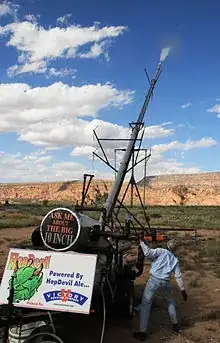Not viable... unless maybe Nikola Tesla came on the scene just a bit earlier
With the greatest respect for my learned colleague, speed isn't the problem. Astronauts travel much faster than a bullet. The problem is acceleration.
Whether a small bullet or a large cargo/human-carrying shell, the nature of a cannon is that a big bang occurs, propelling the shell through a barrel. The mathematics of ballistics are well-known, but let's take an example from that link:
$$s=v_xt=\frac{2v_{i}^2sin\theta cos\theta}{g}$$
So, a 75 km throw requires a muzzle velocity ($v_i$) of 860 m/s. Let's say the barrel was 100m long. To get to 860 m/s in 100 m requires an acceleration of...
$$a=\frac{v_{1}^2-v_{0}^2}{2s} = \frac{(860 m/s)^2}{200 m} = 3,690 \frac{m}{s^2}$$
The consensus is that 9G is the maximum acceleration the human body can withstand and your cannon must impose a catastrophic 376G to ship the shell 75 klicks.
Your people are a thin, strawberry paste on the back of the capsule.
Now let's bring someone like Nikola Tesla or one of the pioneers in magnetics into the mix...
Let's pretend that on your world Nikola Tesla was given decent funding, was able to actually stay focused on one project long enough to do something useful with it, and was born early enough to affect your world. What might you have?
Rail guns
Modern rail guns are, in fact, quite a bit worse than cannons when it comes to acceleration — but that's because they can. They can also, over a long enough distance, more slowly accelerate a capsule to pretty much any velocity. This is good for you! Because it means you can use the argument of a magnetic rail gun to lob pretty much anything you want as far as you want.
As long as you explain the "barrel" length.
The honor of the largest practical super gun1 goes to the Schwere Gustav, a WWII monster with a 32.5 m barrel length. And you can now see your problem. Long, straight tubes (or open rails, but tubes are better for a lot of reasons) are a pain in the honking neck. Just to lob your soldiers to lunch, 75 klicks away, you need a muzzle velocity of 860 m/s and you need to get there in less than 9Gs. Let's use 9Gs for convenience just so you know your shortest "barrel" length.
$$t=\frac{v_1 - v_0}{a} = \frac{860}{88.254} = 9.744 seconds$$
OK, so we're traveling at a constant velocity of $88.254 \frac{m}{s^2}$ for 9.744 seconds, which means your barrel length is...
$$s=v_i t+\frac{1}{2}at^2 = 0+\frac{1}{2}(88.254)(9.744)^2 = 4.189 km$$
I have one word for you, just one word... centrifuge
How do you get a 4 km barrel length? With a coil! Spin the troops around a dozen times and spit them out a short length of straight pipe! We've been spinning astronauts around for decades, so we know it can be done, right?
Suck it up, cupcake!
And it would make a cool story....
1 There have been longer barrel super guns, but not by much. The Paris Gun in WWI was said to have a barrel length of 34m. The award was given to the Schwere Gustav for a number of reasons including its calibre. Let's face it. It was a bad boy and whomever was on the receiving end experienced a world of hurt.
